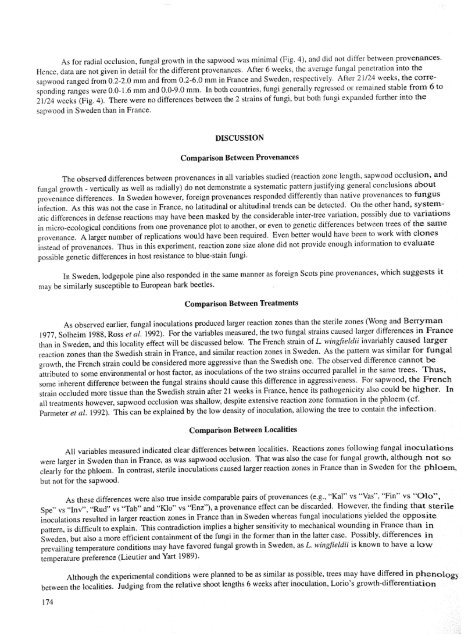View or print this publication - Northern Research Station - USDA ...
View or print this publication - Northern Research Station - USDA ...
View or print this publication - Northern Research Station - USDA ...
You also want an ePaper? Increase the reach of your titles
YUMPU automatically turns print PDFs into web optimized ePapers that Google loves.
As f<strong>or</strong> radial occlusion, fungal growth in the sapwood was minimal (Fig. 4), and did not differ between provenances.<br />
Hence, data are not given in detail f<strong>or</strong> the different provenances. After 6 weeks, the average fungal penetration into the<br />
sapwood ranged from 0.2-2.0 mm and from 0.2-6.0 mm in France and Sweden, respectively. After 21/24 weeks, the c<strong>or</strong>responding<br />
ranges were 0.0-1.6 mm and 0.0-9.0 ram. In both countries, fungi generally regressed <strong>or</strong> remained stable from 6 to<br />
21/24 weeks (Fig. 4). There were no differences between the 2 strains of fungi, but both fungi expanded further into the<br />
sapwood in Sweden than in France.<br />
DISCUSSION<br />
Comparison Between Provenances<br />
The observed differences between provenances in all variables studied (reaction zone length, sapwood occlusion, and<br />
fungal growth - vertically as well as radially) do not demonstrate a systematic pattern justifying general conclusions about<br />
provenance differences. In Sweden however, f<strong>or</strong>eign provenances responded differently than native provenances to fungus<br />
infection. As <strong>this</strong> was not the case in France, no latitudinal <strong>or</strong> altitudinal trends can be detected. On the other hand, systematic<br />
differences in defense reactions may have been masked by the considerable inter-tree variation, possibly due to variations<br />
in micro-ecological conditions from one provenance plot to another, <strong>or</strong> even to genetic differences between trees of the same<br />
provenance. A larger number of replications would have been required. Even better would have been to w<strong>or</strong>k with clones<br />
instead of provenances. Thus in <strong>this</strong> experiment, reaction zone size alone did not provide enough intbrmation to evaluate<br />
possible genetic differences in host resistance to blue-stain fungi.<br />
In Sweden, lodgepole pine also responded in the same manner as f<strong>or</strong>eign Scots pine provenances, which suggests it<br />
may be similarly susceptible to European bark beetles.<br />
Comparison Between Treatments<br />
As observed earlier, fungal inoculations produced larger reaction zones than the sterile zones (Wong and Berryman<br />
1977, Solheim 1988, Ross et al. 1992). F<strong>or</strong> the variables measured, the two fungal strains caused larger differences in France<br />
than in Sweden, and <strong>this</strong> locality effect will be discussed below. The French strain of L. wingfieldii invariably caused larger<br />
reaction zones than the Swedish strain in France, and similar reaction zones in Sweden. As the pattern was similar f<strong>or</strong> fungat<br />
growth, the French strain could be considered m<strong>or</strong>e aggressive than the Swedish one. The observed difference cannot be<br />
attributed to some environmental <strong>or</strong> host fact<strong>or</strong>, as inoculations of the two strains occurred parallel in the same trees. Thus,<br />
some inherent difference between the fungal strains should cause <strong>this</strong> difference in aggressiveness. F<strong>or</strong> sapwood, the French<br />
strain occluded m<strong>or</strong>e tissue than the Swedish strain after 21 weeks in France, hence its pathogenicity also could be higher. In<br />
all treatments however, sapwood occlusion was shallow, despite extensive reaction zone f<strong>or</strong>mation in the phloem (cf.<br />
Parmeter et al. 1992). This can be explained by the low density of inoculation, allowing the tree to contain the infection.<br />
Comparison Between Localities<br />
All variables measured indicated clear differences between localities. Reactions zones following fungal inoculations<br />
were larger in Sweden than in France, as was sapwood occlusion. That was also the case f<strong>or</strong> fungal growth, although not so<br />
clearly tbr the phloem. In contrast, sterile inoculations caused larger reaction zones in France than in Sweden f<strong>or</strong> the phloem,<br />
but not f<strong>or</strong> the sapwood.<br />
As these differences were also true inside comparable pairs of provenances (e.g., "Kal" vs "Vas", "Fin" vs "Olo",<br />
Spe" vs "Inv", "Rud" vs "Tab" and "Klo" vs "Enz"), a provenance effect can be discarded. However, the finding that sterile<br />
inoculations resulted in larger reaction zones in France than in Sweden whereas fungal inoculations yielded the opposite<br />
pattern, is difficult to explain. This contradiction implies a higher sensitivity to mechanical wounding in France than in<br />
Sweden, but also a m<strong>or</strong>e efficient containment of the fungi in the f<strong>or</strong>mer than in the latter case. Possibly, differences in<br />
prevailing temperature conditions may have fav<strong>or</strong>ed fungal growth in Sweden, as L. wingfieldii is known to have a low<br />
temperature preference (Lieutier and Yart 1989).<br />
Although the experimental conditions were planned to be as similar as possible, trees may have differed in phenology<br />
between the localities. Judging from the relative shoot lengths 6 weeks after inoculation, L<strong>or</strong>io's growth-differentiation<br />
174<br />
:i
















